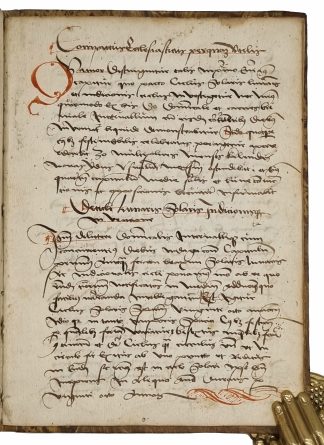ALBERTUS MAGNUS, Pseudo.
WITH A UNIQUE ASTROLOGICAL MS
Secreta mulierum ab Alberto Magno composita
[Speyer], [Conrad Hist], [about 1495-97]£22,500.00
4to, 34 unnumbered leaves (last blank), + 17 manuscript leaves. Gothic letter, large woodcut depicting a school scene to t-p, a bit dusty with crude early repair to upper outer corner, light age yellowing, occasional foxing and spot to margins, insignificant waterstain to upper edges, light oil splashes to last 3 ll. not affecting reading. Manuscript averaging 28 lines, brown ink in two different gothic cursive hands (the first German, the second possibly Flemish or Dutch), first initial and underlining in red, red pen flourishing at foot of first ms. leaf, one ms. horoscope diagram. A good copy in early C19 patterned boards, vellum spine, label of Ernest Thorin (C19 bookseller in Paris) to front pastedown.
A remarkable copy of this treatise on human reproduction by Pseudo Albertus Magnus, bound with a 17-page manuscript containing a astronomical text on the principles of chronological computation, apparently for astrological purposes, doubtless inspired by the printed text and an intriguing example of manuscript and print at the time of their transition.
‘Secreta Mulierum’ (On women’s secrets) was composed in the late 13th or early 14th century by an unknown disciple of Albertus Magnus, the most learned and prolific writer of the Middle Ages. Although scholars proposed the names of Thomas of Brabant or Henry of Saxony, the problem of authorship remains unsolved. The main text is accompanied by, and at times mixed with, a commentary, whose attribution is also debated. Relying on ancient and medieval writings, Pseudo-Albert discusses various aspects of reproduction, including the generation of the embryo, the formation and development of the fetus, the signs of conception, virginity, chastity, defects of the womb, impediments to conception and others. In the introduction, he states that his style will be “partly philosophical, partly medical, just as seems to fit the material”. By “philosophical” he refers to natural philosophy, or natural science, concerned with the study of the world and cosmos. Although Pseudo-Albert raises a number of medical topics – nature of the menses, birth complications, gestation – his knowledge of medicine is limited. On the other hand, the discussion on natural philosophy is complex and it explores in detail the relationship between human nature, reproduction and celestial bodies. Crucially, the author describes the effects of astrological influence on the developing fetus, also showing how the sphere of the fixed stars confers different virtues: Saturn gives the ability to reason, the Sun to remember, Jupiter grants generosity, Venus causes the separation of hands and feet, the Moon completes the skin. “Vincent of Beauvais and Michael Scot may note some of the celestial effects, but pseudoAlbert addresses himself seriously to the problem of how they come about, and this effort forms the major thrust of his writing. Although the De secretis mulierum names women’s secrets as its subject matter, if we weigh the length and the level of discourse we can almost consider this to be an astrological treatise.” (Lemay)
Renaissance scholars commonly practiced astrology, and the manuscript pages at the end suggest that the early owner of this volume was particularly involved. The text is a ‘Computus Ecclesiasticus’, which discusses solar and lunar cycles in relation to religious festivities and mobile feasts of the ecclesiastical calendar (Julian). In addition to basic knowledge (e.g. what is a lunar cicle), it provides precise instructions on how to calculate (‘computare’) dates of feast days, such as ‘dies dominicales’(Sundays). Interestingly, it is arranged around metric formulas that were traditionally used to memorise calculations: here these are underlined in red, and each word corresponds to a number or provides a letter which will be used in the computations. For example, we find “Sed, Quinque, Tred, Ambo, Decem, Doc, Septem, Quind, Quater, Dud, Jota, Novem, Sept VI, Quard”, used to calculate the ‘Golden number’ (a number from 1 to 19 which designate the year within the Metonic cycle of the moon phases). We also find: “Bonus erat homo Katho, nobilis quoque Seno”, which was employed to calculate the insertion of a leap day, week or year into a calendar and the second part of the manuscript is mostly concerned with this. Learning ‘computus’, the science of calculating times and dates, was fundamental for astrologers. This discipline, used in conjunction with astrolabes to predict the position of the planets (mentioned in the manuscript) and astronomical tables, was used to cast horoscopes, exactly like the one that we find at the beginning of the manuscript. The text was composed by two writers between the end of the 15th and beginning of the 16th century: in a few places, the second updates and annotates the first, including adding ‘ab anno 1500’ and ‘1501’ to his comments.
USTC 742409; ISTC ia00313900; GW 734; Bod-Inc: A-135; Klebs 26.16. This ed not in Goff, Cantamessa, Stillwell, Heirs of Hippocrates or Wellcome I.In stock










